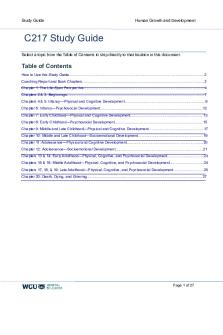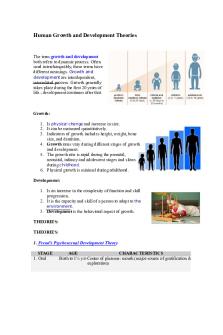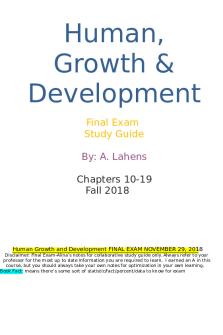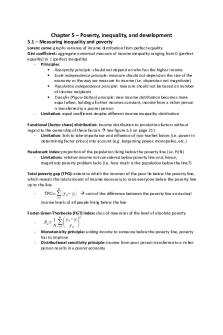EPC 202 Human Growth AND Development PDF

| Title | EPC 202 Human Growth AND Development |
|---|---|
| Author | WILSON Kajuki |
| Course | Strategic management |
| Institution | The Presbyterian University of East Africa |
| Pages | 28 |
| File Size | 437.6 KB |
| File Type | |
| Total Downloads | 8 |
| Total Views | 150 |
Summary
HUMAN GROWTH AND DEVELOPMENT...
Description
THE PRESBYTERIAN UNIVERSITY OF EAST AFRICA
COURSE CODE: EPC 202
COURSE TITLE: HUMAN GROWTH AND DEVELOPMENT
LECTURE NOTES
LECTURER: JASTO M.MAORE EDITION : APRIL 2020
1
EPC 202: HUMAN GROWTH AND DEVELOPMENT SELECTED TOPICS TOPIC 1: INTRODUCTION 1.1 Definition of Terms 1.1.1 Growth 1.1.2 Development 1.2 Rationale for studying Human Growth and Development TOPIC 2: HUMAN DEVELOPMENT 2.1 Principles of Human Development 2.2 Factors affecting Human Development TOPIC 3: THEORIES OF HUMAN DEVELOPMENT 3.1 Psychoanalytic Theory of Sigmund Freud 3.2 Psychosocial Theory of Erik Erikson 3.3 Piaget’s Theory of Cognitive Development TOPIC 4: STAGES OF HUMAN DEVELOPMENT 4.1 Amstrong’s 12 stages of Human Development TOPIC 5: DEVELOPMENT OF PERSONALITY 5.1 Definition of Personality 5.2 Characteristics of Personality 5.3 Theories of Personality TOPIC 6: MOTIVATION 6.1 Definition of Motivation 6.2 Types of Motivation 6.3 Maslow’s Hierarchy of Needs
2
EPC 202: HUMAN GROWTH AND DEVELOPMENT TOPIC 1: INTRODUCTION Definition of Terms Growth Growth refers to physical increase in some quantity over time. It includes changes in terms of height, weight, body proportions and general physical appearance. Hurlock has defined Growth as change in size, in proportion, disappearance of old features and acquisition of new ones. Growth refers to structural and physiological changes (Crow and Crow, 1962). Thus, growth refers to an increase in physical size of whole or any of its part and can be measured. Development Development refers to the qualitative changes in the organism as whole. Development is a continuous process through which physical, emotional and intellectual changes occur. It is a more wider and comprehensive term than growth. It is also possible without growth. According to Crow and Crow (1965) development is concerned with growth as well as those changes in behavior which results from environmental situation.
Rationale for studying Human Growth and Development 1.Understanding ourselves Better Studying human development can also help you learn more about your future. By understanding the aging process, you will be better prepared when you face issues associated with growing older. 2.To know more about the Children Whether you are a parent now or are planning to become one in the future, studying human development can teach you a great deal about your children. In addition to learning things that can help make you a better parent, you can gain greater insight into how your children behave, think, learn, and feel.
3
3.To improve our interaction skills with Children If you plan on having children or working with them at some point, studying human development can greatly improve your ability to interact with kids.Once you better understand the stages of development and what makes kids tick, you will feel more comfortable talking, playing, and working with them. 4.To appreciate various stages of Development When we think of human development, it is easy to think of it as a process that is largely complete once we hit early adulthood. It is important to realize, however, that development is an ongoing process that continues all throughout life. 5.To understand Human Normality Another important reason to study development is that one can gain a greater understanding of what is normal. While every person is a little bit different, human development tends to follow a remarkably predictable pattern. Once you have studied development, you will know what is typical at certain ages and stages.
TOPIC 2: HUMAN DEVELOPMENT Principles of Human Development 1.Development involves change The human being is undergoing changes from the moment of conception to the time of death. There are different types of change occur such as, changes in size, proportions, disappearance of old features and acquisition of new features etc. 2.Development is a continuous process Development continues throughout the life of an individual. This process takes place in interaction with the environment in which a person lives. One stage of development is the basic framework for the next stage of development. A child has limited knowledge and experiences about his environment.
4
3. Development follows a direction and uniform pattern in an orderly manner (i) Development proceeds from the center of the body outward. This is the principle of proximodistal development that describes the direction of development (from nearer to far apart). It means that the spinal cord develops before outer parts of the body. The child’s arms develop before the hands and the hands and feet develop before the fingers and toes. ii)Development proceeds from the head downwards. This is called the cephalocaudal principle. According to this principle, development occurs from head to tail. The child gains control of the head first, then the arms and then the legs. 4.Individual Differences in the Development Process Even though the pattern of development is similar for all children but the rate of development varies among children. Each child develops as per his abilities and perception of his environment. 5. Development depends on maturation and learning Maturation refers to the sequential characteristic of biological growth and development. The biological changes occur in sequential order and give children new abilities. Changes in the brain and nervous system account largely for maturation. These changes in the brain and nervous system account largely for maturation. 6. Development is predictable Human development is predictable during the life span. Although this development is influenced by both genetic and environmental factors, however, it takes place in a pre-defined manner. Specific areas of development, such as: different aspects of motor development, emotional behavior, speech, social behavior, concept development, goals, intellectual development etc. follow predictable patterns.
7. Early development is more critical than later development According to Milton
childhood shows the man, as morning shows the day. Similarly,
Erikson views childhood is the scene of man‟s beginning as man. He explains that if parents gratify the needs of the child for food, attention and love etc.
8. Development involves Social expectations. In every society there are certain rules, standards and traditions which everyone is expected to follow. Development is determined by social norms and expectations of behaviors form the individuals. Children learn customs, traditions and values of the society and also what behaviors are expected from them. 5
Factors affecting Human Development Human development is the process in which the changes occur in all the aspects of an organism from conception to death. All children also do not have same type of intelligence. Some have more musical talents, others have more intrapersonal intelligence, others also have more linguistic abilities etc. So, children differ from each other because several factors influence on their development. Some of the important factors have been enumerated below: 1.Hereditary Factors Heredity exerts an influence on human development. The child carries genetic endowments from his/her parents. It is genetically transmitted characteristics from one generation to the next. 2) Environmental Factors Another important factor of human development is the environment where an individual lives. The child lives and grows in his environment. Environment consists of a wide range of stimuli and it provides the necessary input and experiential base for development of the child. Enrichment or impoverishment of the environment would produce differences in his abilities.
3) Home Environment Home environment exerts tremendous influence on child’s understanding of the external world. It builds self-concept and prepares him to face the external world. The child begins to acquire knowledge through interaction with parents and other family members. During his early years of development, the behaviours of the child are modulated by the home environment. The environment of the family can be supportive or stressful for the child. If it is supportive, warm and harmonious environment, the child develops normally. In unsupportive and stressful home environment, broken families or uncaring parents in the family, children may develop as maladjusted persons.
4) Cultural Factors Culture refers to a system of beliefs, attitudes and values that are transmitted from one generation to the next. It is a product of past human behavior and is also a shaper of future aspirations. The development of the child is influenced by family as well as by the society. The child learns the habits, beliefs, attitude, skills and standards of judgment through the socialization processes. 6
5) Socioeconomic Status Socioeconomic Status plays a pivotal role in human development. The index of socioeconomic status is determined by parental education, occupation and income. The children of low socioeconomic status may develop as mal-nourished, suffer from lack of knowledge in many aspects and their normal development may get hampered.
6) Normative influences Normative influences occur in a similar way for majority of people in a particular group. These influences may be biological or environmental. For example, biological events like sexual maturity or deterioration in old age. Environmental events, like entering the school at about 6 years of age, parenthood etc. have the same influences on individuals. Most of the people of the same age, at same place and time and generation have common biological and environmental influences such as floods, famines and other natural disasters. Non-normative influences include the unusual life events in an individual’s life. For example, death of a parent when a child is young or birth defects etc.
7) Education and Training Each child is equipped with certain abilities which need to be nurtured through proper education and training. Therefore, the first and foremost step is to identify and recognize the ability of the child and the next step is to provide adequate opportunities to develop the same. If proper identification of the ability is not possible and adequate facilities are not available to the child, then his innate ability may not be developed. Thus, adequate education and training have influence on human development.
TOPIC 3: THEORIES OF HUMAN DEVELOPMENT Psychoanalytic Theory of Sigmund Freud Sigmund Freud (1856 – 1939) is considered to be the founder of the psychodynamic approach to psychology, which looks to unconscious drives to explain human behavior. Freud believed that the mind is responsible for both conscious and unconscious decisions that it makes on the basis of psychic drives. His psychoanalytic theory was based on four main areas namely: 7
1.The Theory of the Mind 2.The structure of Personality 3.Psychosexual Stages 4.Defence mechanisms The Theory of the mind According to Freud there are three active parts in the mind namely: i) The Conscious Mind ii) The Pre-Conscious iii) Unconscious Mind
Conscious Mind The Conscious Mind lies just above the surface of the water like the tip of an iceberg and occupies only one-tenth of our total mental life. The ideas, thoughts and images that we are aware of at any moment of our mental life are said to lie within this upper layer of our mind.
Preconscious Just beneath the Conscious layer lies the Preconscious or the Subconscious mind. This middle portion of our mind stores all types of information just beneath the surface of awareness dormant or untapped which can be easily brought to the level of consciousness at a moment’s notice whenever required. Thus in the middle bed or layer of the human mind there lie all experiences or knowledge which have been gained or learned by an individual through various types of experiences or training.
Unconscious Below the Preconscious mind lies the Unconscious, the most important part of our mind. It is related to the vast part of our mental life which is hidden and usually inaccessible to the conscious. It contains all the repressed wishes, desires, feelings, drives and motives, many of which relate to sex and aggression. All these repressed and forbidden desires and ideas are not destined to lie permanently in the unconscious. They usually strive and agitate to come up to the preconscious or the conscious layers of the mind, sometimes in disguised forms, in dreams and in reveries. This hidden treasure of mental life belonging to the unconscious is thus responsible for most of our behaviour and in fact, as Freud asserts, ‘What we do and 8
how we behave is always determined by the forces residing in our unconscious and not by the choices of the conscious.’
The structure of Personality Freud divided the structure of personality into three parts The Id According to Freud, the id is the most primitive part of the personality and the only component that is present from birth- from which the ego and the super-ego later develops. The id is the unorganised part of the personality structure that contains a human’s basic, instinctual drives. It is the source of our bodily needs, desires, and impulses, particularly our sexual and aggressive drives. The id contains the libido (sexual desire), which is the primary source of institutional force that is unresponsive to the demands of reality. It consists of such ambitions, desires, tendencies and aptitude as are guided by the pleasure principle.
The Ego A new part of personality, the ego develops as the young child learns to consider the demands of reality. The ego acts according the reality principle, i.e. it seeks to please the id’s drive in realistic ways that will benefit in the long term rather than bring grief. It functions, as a policeman to check the unlawful activities of the id. The reality principle that operates the ego is a regulating mechanism that enables the individual to delay gratifying immediate needs and function effectively. An example would be to resist the urge to grab other people’s belongings, but instead to purchase those items.
The Super-ego The third part of the personality is the super-ego which judges whether actions are right or wrong. It is the agency which internalizes the parental influences and ideals of society through early childhood experiences. It is the individual’s conscience, as well as his/her image or the morally ideal person . It represents the ideal rather than the real and strives for perfection. It works in accordance with the moral standards authorised by the agents of society. The super-ego works in contradiction to id. The super-ego strives to act in a socially appropriate manner, whereas the id just wants instant self-gratification. The super-ego controls our sense of right and wrong and guilt.
9
Psychosexual Stages Freud's theory of psychosexual development is represented amongst five stages. According to Freud, each stage occurs within a specific time frame of one's life. If one becomes fixated in any of the four stages, he or she will develop personality traits that coincide with the specific stage and its focus. 1. Oral Stage The first stage is the oral stage. An infant is in this stage from birth to eighteen months of age. The main focus in the oral stage is pleasure seeking through the infant’s mouth. During this stage, the need for tasting and sucking becomes prominent in producing pleasure. Oral stimulation is crucial during this stage. If the infant’s needs are not met during this time frame he or she will be fixated in the oral stage. Note: Fixation in this stage can lead to adult habits such as thumb-sucking, smoking, overeating, and nail-biting. Personality traits can also develop during adulthood that are linked to oral fixation; these traits can include optimism and independence or pessimism and hostility. 2. Anal Stage The second stage is the anal stage which lasts from eighteen months to three years of age. During this stage the infant’s pleasure seeking centers are located in the bowels and bladder. Parents stress toilet training and bowel control during this time period. Fixation in the anal stage can lead to anal-retention or anal-expulsion. Anal retentive characteristics include being overly neat, precise, and orderly while being anal expulsive involves being disorganized, messy, and destructive. 3. Phallic Stage The third stage is the phallic stage. It begins at the age of three and continues until the age of six. Now sensitivity becomes concentrated in the genitals and masturbation (in both sexes) becomes a new source of pleasure. The child becomes aware of anatomical sex differences, which sets in motion the conflict jealousy and fear which Freud called the Oedipus complex (in boys). Later the Freud scholars added Electra complex (in girls).
10
4. Latency Stage The fourth stage is the latency stage which begins at the age of six and continues until the age of eleven. During this stage there is no pleasure seeking region of the body, instead all sexual feelings are repressed. Thus, children are able to develop social skills, and find comfort through peer and family interaction. 5. Genital Stage The final stage of psychosexual development is the genital stage. This stage starts from eleven onwards, lasts through puberty, and ends when one reaches adulthood at the age of eighteen. The onset of puberty reflects a strong interest from one person to another of the opposite sex. If one does not experience fixation in any of the psychosexual stages, once he or she has reached the genital stage, he or she will grow into a well-balanced human being.
Defense Mechanisms In psychoanalytic theory, a defense mechanism is an unconscious psychological mechanism that reduces anxiety arising from unacceptable or potentially harmful stimuli. Sigmund Freud noted a number of ego defenses which were noted throughout his work but his daughter, Anna Freud, developed and elaborated on them. Some of the defense mechanisms are as follows: 1) Denial- believing that what is true is actually false 2) Displacement- taking out impulses on a less threatening target 3) Intellectualization- avoiding unacceptable emotions by focusing on the intellectual aspects 4) Projection- attributing uncomfortable feelings to others 5) Rationalization- creating false but believable justifications 6) Reaction Formation- taking the opposite belief because the true belief causes anxiety 7) Regression- going back to a previous stage of development 8) Repression- pushing uncomfortable thoughts out of conscious awareness 9) Suppression- consciously forcing unwanted thoughts out of our awareness 10) Sublimation- redirecting ‘wrong’ urges into socially acceptable actions. These defenses are not under our conscious control and our unconscious will use one or more to protect one's 11
self from stressful situations. They are natural and normal and without these, neurosis develops such as anxiety states, phobias, obsessions, or hysteria.
Psychosocial Theory of Erik Erikson The theory of psychosocial development created by Erik Erikson is perhaps one of the bestknown personality theories. The theory differs from many others in that it addresses development across the entire lifespan, from birth through death. Erikson came up with the Eight stages of Psychosocial Development namely: 1.Trust vs. Mistrust 2.Autonomy vs. Shame and Doubt 3.Initiative vs. Guilt 4.Industry vs. Inferiority 5.Identity vs. Confusion 6.Intimacy vs. Isolation 7.Generativity vs. Stagnation 8.Integrity vs. Despair Stage 1: Trust Versus Mistrust Trust versus mistrust is the earliest psychosocial stage that occurs during the first year or so of a child's life. During this critical phase of development, an infant is utterly dependent upon his or her caregivers. When parents or caregivers respond to a child's needs in a consistent and caring manner, the child then learns to trust the world and the people around him. Stage 2: Autono...
Similar Free PDFs

EPC 202 Human Growth AND Development
- 28 Pages

Human growth and development
- 46 Pages

Growth & Development
- 4 Pages

Growth and Development Notes
- 10 Pages

Growth and development chart
- 9 Pages

Growth and Development CH01 exam
- 40 Pages
Popular Institutions
- Tinajero National High School - Annex
- Politeknik Caltex Riau
- Yokohama City University
- SGT University
- University of Al-Qadisiyah
- Divine Word College of Vigan
- Techniek College Rotterdam
- Universidade de Santiago
- Universiti Teknologi MARA Cawangan Johor Kampus Pasir Gudang
- Poltekkes Kemenkes Yogyakarta
- Baguio City National High School
- Colegio san marcos
- preparatoria uno
- Centro de Bachillerato Tecnológico Industrial y de Servicios No. 107
- Dalian Maritime University
- Quang Trung Secondary School
- Colegio Tecnológico en Informática
- Corporación Regional de Educación Superior
- Grupo CEDVA
- Dar Al Uloom University
- Centro de Estudios Preuniversitarios de la Universidad Nacional de Ingeniería
- 上智大学
- Aakash International School, Nuna Majara
- San Felipe Neri Catholic School
- Kang Chiao International School - New Taipei City
- Misamis Occidental National High School
- Institución Educativa Escuela Normal Juan Ladrilleros
- Kolehiyo ng Pantukan
- Batanes State College
- Instituto Continental
- Sekolah Menengah Kejuruan Kesehatan Kaltara (Tarakan)
- Colegio de La Inmaculada Concepcion - Cebu









